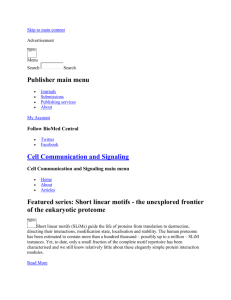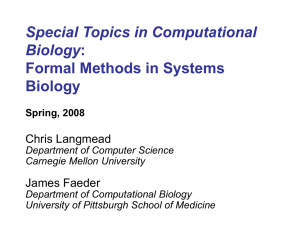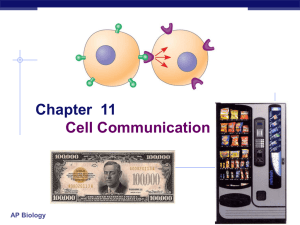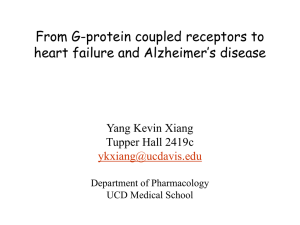The joy of computational biology!
advertisement
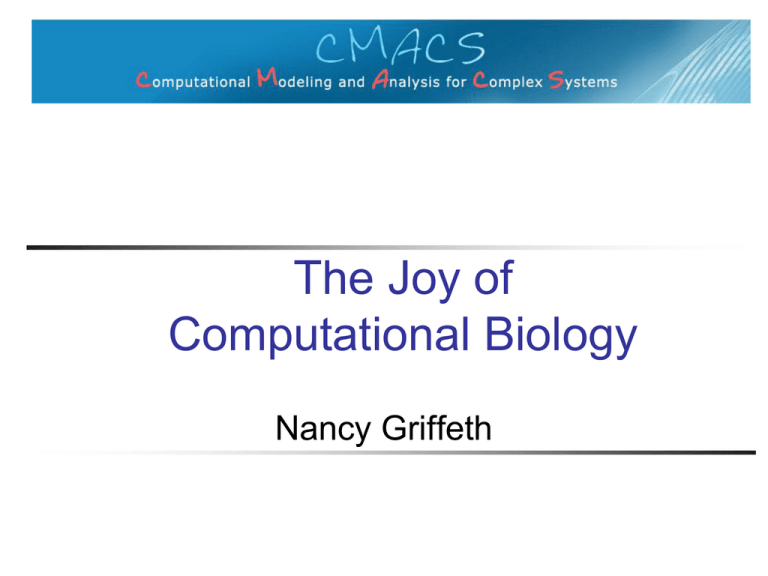
The Joy of Computational Biology Nancy Griffeth Outline What will we be doing Why I think computational biology is fun Workshop Information Subject Matter How to model signaling pathways, such as those that control cell proliferation Workshop Information>Schedule Schedule This week: Introductory lectures Next week: Initial modeling problems Third week: Projects Last two days Team presentations Final visiting lecture Workshop Information>Pedagogical Approac Pedagogical Approach Collaborative Questions are always welcome Discussion is encouraged! Scribe to record unanswered questions Problem-oriented: three problems Frog cell cycle EGFR signaling pathway First passage time distributions Workshop Information>Pedagogical Approac Pedagogical Approach Interdisciplinary team oriented At least 1 chemistry/biology expert At least 1 computer science expert At least 1 math expert Workshop Information>Pedagogical Approac Speaking of Interdisciplinary… xkcd.com Workshop Information>Pedagogical Approac General Learning Objectives Be aware of some hypotheses about how cancers develop Be able to model cellular signaling pathways Learn to function on interdisciplinary teams Investigate some research problems Meet new people and have some fun! Workshop Information>Pedagogical Approac Specific Learning Objectives Learn how cells initiate cell division using signaling Investigate the mechanisms that initiate cell division and ensure that cells are copied accurately Be able to model signaling pathways that initiate cell division, using wiring diagrams and reaction rules Create computer-processable models of signaling pathways Simulate their behavior Investigate their properties Study distributions of first passage times, to support research on coarse-graining models Questions or Discussion? What’s I like about comp bio Biology matters! Computational techniques help us understand biology Cells act a lot like computers Cells make binary choices Cells have modular parts Different kinds of cells share the same mechanisms Computational techniques Organize data Describe behaviors as a whole Bridge gaps where data is missing Suggest hypotheses Example 1: Cell Cycle Regulation Cell Cycle Regulation Example 2: Protein Production Transcription Translation Figure from wikipedia article on the central dogma Transcription Protein Production Wiring diagrams Negative autoregulation: a protein represses its own production Provides a quick increase to a robust level Protein Production Figure from Alon, “An Introduction to Systems Biology” cAMP signals absence of glucose cAMP activates X X binds to the DNA promoter, but is not enough by itself to start arabinose metabolism X promotes transcription of Y; arabinose activates Y X and Y together binding to the DNA promoter results in production of the enzymes that metabolize arabinose What triggers activation of transcription factors? An external signal (molecule) arrives Binds to a receptor Changes in the receptor cause internal actions… Which cause cascading actions Example 3: Regulating cell growth, proliferation, and differentiation Example 4: Cell as Information Processor http://en.wikipedia.org/wiki/Cell_signaling Example 5: Protein degradation Ubiquitin Tags proteins for destruction Like garbage collection!! Rulebender Tool Research Problems Curing cancer: How do signaling pathways relate to the development of cancer? Computational complexity: how can we simplify the models enough to make them tractable? Relationship to cancer Mitosis signals stay in on position Cells learn to send growth signals to themselves Cells send growth signals to other cells inappropriately Cells send signals for creation of blood vessels Simplifying models Computationally complex Modular? Course-graining Need subsystems with behavior we can characterize What you will learn… Regulation of the cell cycle A rule-based language to model cellular processes High-level view of how models can be “solved” Signaling pathways EGFR pathway Model simplification by coarse-graining
